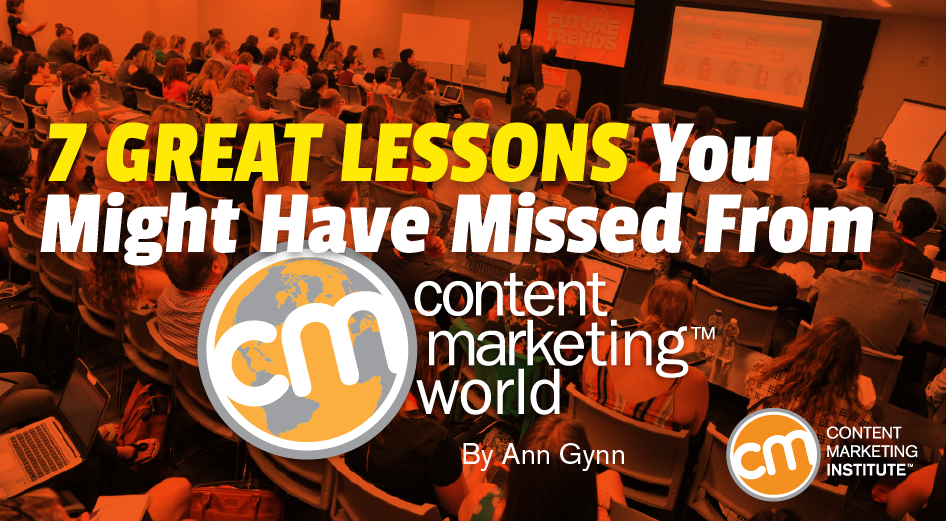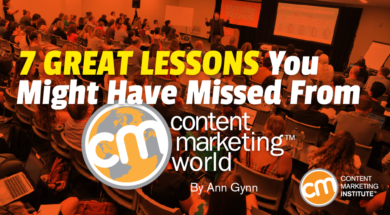
Given the hundreds of sessions at Content Marketing World, I never find the time to attend them all or watch every on-demand video.
But I don’t have to, and neither do you. Content Marketing Institute writers (and some speakers), shared the most relevant and helpful details on the CMI blog.
Here are highlights from articles we published this year that were inspired by Content Marketing World sessions:
Words: Pick ones to convert
Writers and editors are most likely to appreciate the art of word selection – how a well-placed word can make all the difference in a sentence. But all content marketers should appreciate the science of discovering which words convert their audiences.
Chris Goward, founder and CEO of the conversion-optimization company Wider Funnel, went behind the scenes for conversion words in his Content Marketing World presentation, The Ultimate Session on Words That Convert (How to Find ’em and How to Use ’em) – Mobile, E-Commerce, and More.
One critical takeaway for me is this: Making assumptions is fine but making decisions based on assumptions is not. That mantra applies to a lot of things – including how you label your call-to-action buttons. You might be surprised at the words that convert, Chris says.
Don’t assume you know what words will convert. Test your hypothesis, says @ChrisGoward. #CMWorld Click To TweetWhile you might assume the mundane “submit” wouldn’t attract a click, you would be wrong based on an experiment conducted by Chris’ team. They tested three calls to action:
- “Submit”
- “Become a maven”
- “I want in”
The team hypothesized that using the word “maven” would convert better because it connected with the audience’s community. Team members also thought “I want in” would convey a sense of urgency and prompt more people to act.
But those assumptions were wrong. “Submit” outperformed both alternatives.
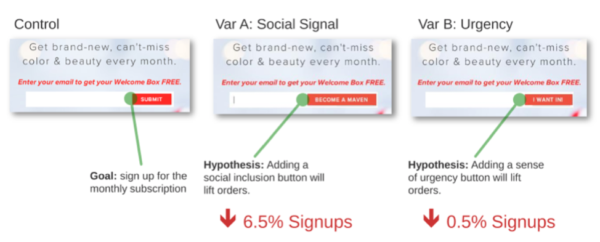
Chris’ point isn’t that all CTA buttons should have the word “submit.” His point is that you must test your assumptions and test them in the appropriate contexts.
Learn more about what Chris had to say: Words That Convert: Test, Learn, Repeat.
Visuals: Don’t make these common mistakes
As a word person, I often use too many, especially in charts and infographics. Scott Berinato helped rectify this with advice from his Content Marketing World presentation Data Visualization and Creating Good Charts.
Heeding the advice, I’ll hit on three mistakes using visuals:
You tell without showing.
You include extraneous details.
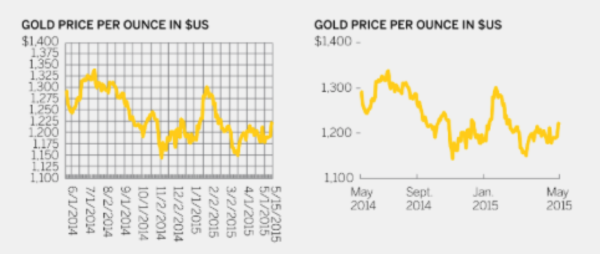
You choose inappropriate chart types.

Learn more common errors with visuals in 6 Mistakes Ruining Your Charts and Infographics.
Videos: Keep them watching
Content Marketing World keynote presenter Tina Fey shared the story of her teen daughter who wanted to watch Saturday Night Live but gave up when she discovered she had to figure out how to use cable TV. A constant YouTube viewer, Tina’s daughter is not unique, particularly for her generation.
Though we may know about YouTube, do we really know how to get our content discovered (and watched)? Tim Schmoyer, CEO of Video Creators, offered some insight in his Content Marketing World presentation, How to Develop a Loyal YouTube Audience.
Tim serves up a comparison of how search works at Google versus YouTube. The goal of both search engines is to deliver the right content at the right time. But Google’s goal is to give an answer and send the searcher on his or her way. YouTube’s goal is to deliver valuable content that entices the searcher to stay (and stay and stay).
#YouTube’s goal is to deliver #content that entices searcher to stay & stay & stay. @TimSchmoyer Click To TweetThat’s why YouTube identifies successful videos as those that extend the viewer’s time on site. It sparks the viewer to watch another video, then another, and another. It looks at starts (videos that led the viewer to begin watching), viewing time (based on total video time), and session (videos contributing to the longest viewing times).
To learn in more detail what Tim had to say about all matters YouTube, read What You Need to Do to Build a Loyal YouTube Audience.
Emails: Automate your best communication vehicle
Email may seem old-school in all the hubbub around new platforms and devices, but it remains an MVP of content marketing. Jessica Best shared how to make the most of it in her Content Marketing World presentation, Email Marketing Automation at Every Level.
Automated emails drive 60% higher open rates and 200% higher click-through rates than batched or business-usual emails, according to emfluence research shared by Jessica.
Of the impressive stats she revealed, the one about automated welcome emails stood out to me. Only 40% of marketers employ them. And yet, Jessica says, it’s likely to receive the “highest open rate you get on any email you send unless you send a birthday email.”
Welcome #emails to new subscribers get the highest open rates except birthday emails. @bestofjess #CMWorld Click To TweetShe shared the Stikwood brand as an example. It sends a welcome email to mailing list subscribers and includes a 10% coupon:
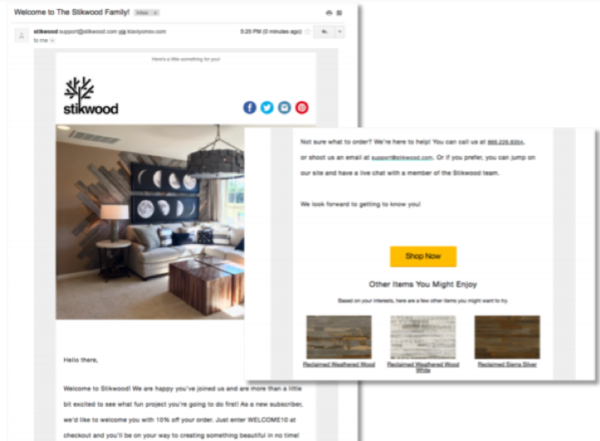
“This coupon generates more revenue than even their abandoned cart email,” according to Jessica.
The lesson? Aim high with your welcome emails. Don’t base them on function (e.g., acknowledging the subscription). Allow them to help close the sale or to move the recipient further down the funnel with an offer of related content or a free trial.
Get more of Jessica’s email insight: Cook Up Email Marketing Automation With These 6 Recipes.
Influencers: Recognize the strategic differences
Influencer marketing is a well-covered topic. But Amisha Gandhi, vice president of influencer marketing at SAP Ariba, spoke about the unique challenges enterprise B2B brands face in the global marketplace – Creating a Global Influencer Marketing Program at a Large B2B Brand – at Content Marketing World.
One of the particularly useful nuggets was the difference between influencer relations and influencer marketing:
- Influencer relations involves top-of-funnel awareness-building (such as events and coverage). At most companies, that’s covered by PR and analyst relations teams who work to earn coverage from journalists, bloggers, and top-tier analyst firms.
- Influencer marketing serves a deeper part of the funnel. Independent analysts, consultants, and other tech experts whom the desired audience and potential buyers already rely on for purchasing guidance make sense here, as do partners and customers.
SAP chose to focus on influencer marketing ahead of one of its events. And though many people think the SAP name would naturally attract responses, that’s not the case. SAP began its influencer marketing outreach like all of us should — introducing yourself, complimenting the influencer’s relevant work, and asking how they engage with brands.
Learn more from Amisha: Influencer Marketing: Lessons from One of the World’s Largest Software Brands.
Audiences: See their loyalty in your funnel
Don’t abandon the funnel but think about it differently. Suite Group CEO Teju Owoye’s Accelerating Growth by Hacking Your Conversion Journey presentation at Content Marketing World advocates for stopping the self-congratulations when a traditional top-of-the-funnel buyer converts to a sale or subscription.
Instead, marketers should ensure that an equal amount of time or commitment is made to provide content that satisfies new customers and new subscribers – and ultimately, retains them.
Marketers should spend equal time providing content to retain customers as they do to attract them. @TejuOwoye Click To TweetShe offered a new view of funnel thinking – two funnels put together and laid on their sides.
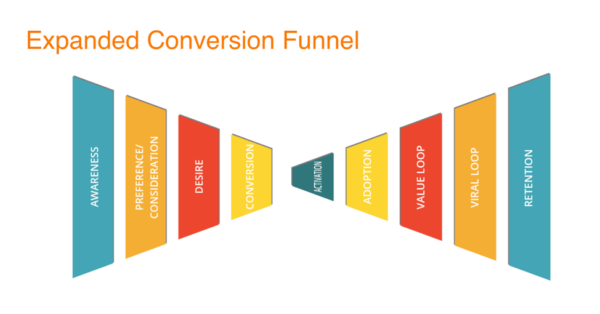
The right side is what Teju calls “our new job as marketers … making sure that the consumer has a delightful experience and is unlocking value at critical points while using your product.”
Not only will you build and grow a loyal audience, many in that audience can become influencers – formal or informal – with others in your target base. And your customers-turned-influencers can provide hot leads to begin on the left side of the funnel. And that’s successful marketing.
Learn more from Teju: How Content Can Create a Self-Sustaining Customer Referral Engine.
Audits: Make them strategic
If you’re planning a content review in the coming year, make sure to read the write-up of content strategist Laura Creekmore’s Content Marketing World presentation, Conducting a Content Audit:
- Identify your main goal.
- Identify the content to include.
- Define your inventory/audit facets.
- Inventory the content to be audited.
- Audit the content in your inventory.
While the steps are straightforward, too many marketers start with Step 4. But a strategic approach is a must. If you don’t know the goals (for your content and for your content audit) you’ll end up with lists of content and analytics, but little idea of how to use all that information effectively.
Laura’s bridge step (No. 3) connects the strategy behind the audit to the implementation – defining what data you will capture is essential.
She even provides a handy template for specifying what data (facets) you’ll explore in the inventory. Make each facet a column in the spreadsheet or other tool you’re using.
Here’s a look at the starter list she provided:
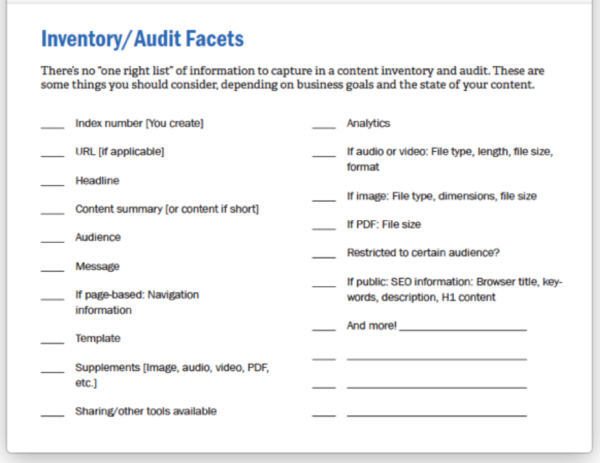
I also appreciated this tip. It’s helpful and funny (a rare moment of levity in a serious task).
When auditing for content quality, don’t go with a binary rating (keep or delete) or numerical scale. Use a more nuanced rating system, Laura said. Put words to describe each rating number because “those shades in the middle are harder unless you put some words on them.” It also enables a more universal understanding among reviewers. She offered the example of “exemplary, good, meh, not good, crap.”
In auditing #content quality, use a rating system w/ words paired w/ numbers. @LauraCreekmore #CMWorld Click To TweetGet all the details from Laura’s content audit presentation: How to Audit Your Content: 5 Essential Steps.
All that and more
As the world’s largest content marketing event, Content Marketing World’s volume of expert presenters is great. From knowing the difference between influencer marketing and influencer relations to classifying content as “crap” in an audit, the nuggets of insight are as varied as the speakers.
What Content Marketing World nuggets did you find most valuable? I’d love to read your distillations in the comments!
Make plans today to attend Content Marketing World 2019 in September. Register by Dec. 31 for the best rates!
Cover image by Joseph Kalinowski/Content Marketing Institute

